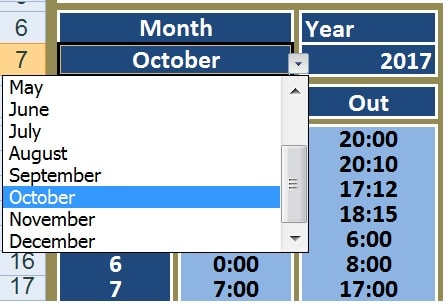

The employee’s overtime threshold is 44 hours and the overtime rate is 1.5 times the regular rate. See example below.Īn employee works as a punch press operator earning $17.00/hour and also as a shipping logistics coordinator earning $20.00/hour for the same employer. In that case, the employee has two regular rates and, as a result, the overtime rate for each hour of overtime is based on the regular rate that applies to the work performed in that hour. If the employee has more than one regular pay rate for overtime work performedĪn employee who is paid on an hourly basis may perform, in one work week, two types of work, each of which attracts a different hourly rate. This is six hours over the overtime threshold of 44 hours.īecause Gerard spent at least 50 per cent of his working hours that week as a dispatcher (a job category that is covered), he qualifies for six hours of overtime pay.
#OVER TIME CALC DRIVER#
Working as a cab driver he is exempt from overtime pay but working in the office as a dispatcher he is not.ĭuring a work week, Gerard worked 26 hours in the office and 24 hours driving a cab, for a total of 50 hours. Gerard works for a taxi company both as a cab driver and as a dispatcher in the office. If at least 50 per cent of the hours the employee works is in a job category that is covered, the employee qualifies for overtime pay. Some of the work might be specifically exempt from overtime pay, while other parts might be covered. Some employees have jobs where they are required to do more than one kind of work.

Different kinds of work ("50 per cent rule") Even if they perform other kinds of tasks that are not managerial or supervisory, they are not entitled to get overtime pay if these tasks are performed only on an irregular or exceptional basis. Managers and supervisors do not qualify for overtime if the work they do is managerial or supervisory. For more information, please see the special rule tool. Others work in jobs where the overtime threshold is more than 44 hours in a work week. Many employees have jobs that are exempt from the overtime provisions of the Employment Standards Act, 2000 ( ESA). over a longer period under an averaging agreement.Unless a contract of employment or a collective agreement states otherwise, an employee does not earn overtime pay on a daily basis by working more than a set number of hours a day. The employee must therefore be paid at a rate of $25.50 an hour for every hour worked in excess of 44 in a week. (This is often called "time and a half.")įor example, an employee who has a regular rate of $17.00 an hour will have an overtime rate of $25.50 an hour (17 × 1.5 = 25.50). Overtime pay is 1½ times the employee’s regular rate of pay. Their hours after 44 must be paid at the overtime pay rate. Interactive tools are available online please use the Employment Standards Self-Service Tool to check compliance with overtime rules and employment standards entitlements.įor most employees, whether they work full-time, part-time, are students, temporary help agency assignment employees, or casual workers, overtime begins after they have worked 44 hours in a work week. Tell us what you think about the information on this page and how you’re using it. Tab to close the table of contents and return to the book. Employment standards enforcement statistics.COVID-19: temporary changes to ESA rules.Crime-related child disappearance leave.Written policy on electronic monitoring of employees.Written policy on disconnecting from work.Mandatory poster and information sheets for employers.Industries and jobs with ESA exemptions and/or special rules.


 0 kommentar(er)
0 kommentar(er)
